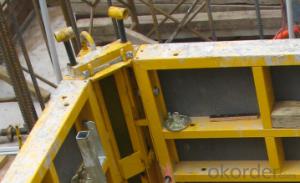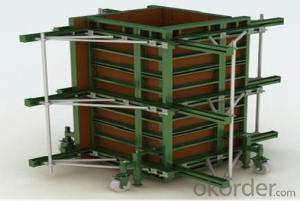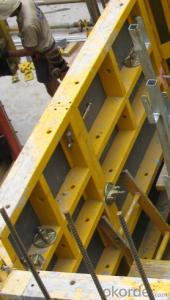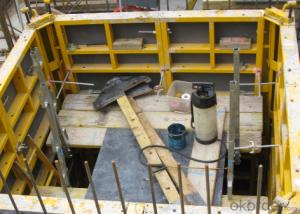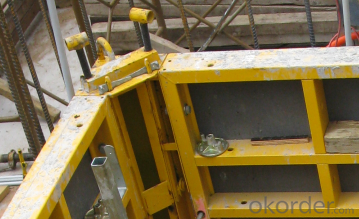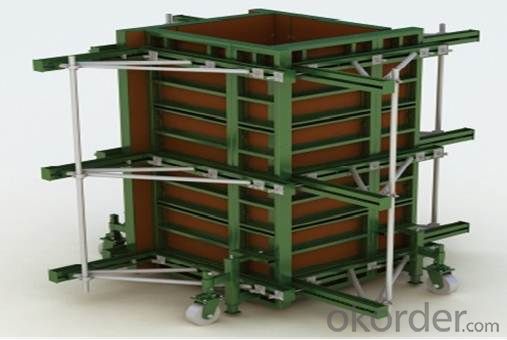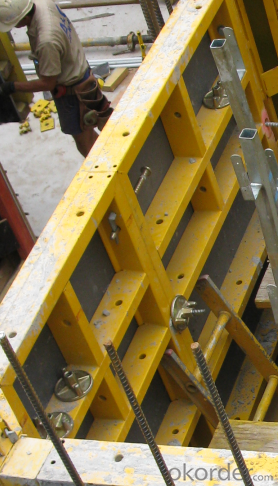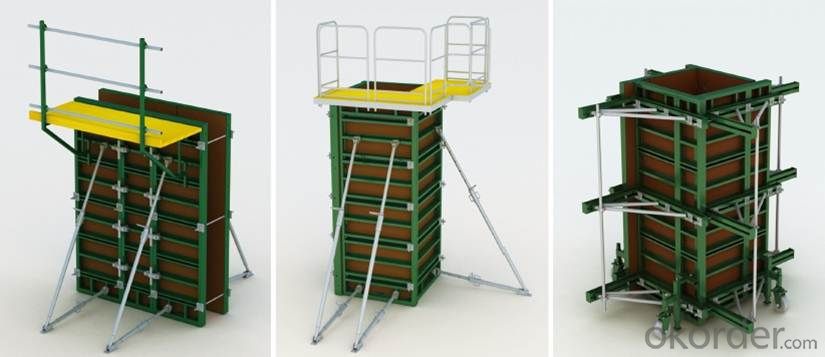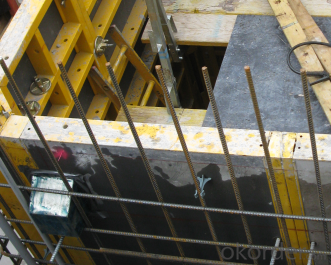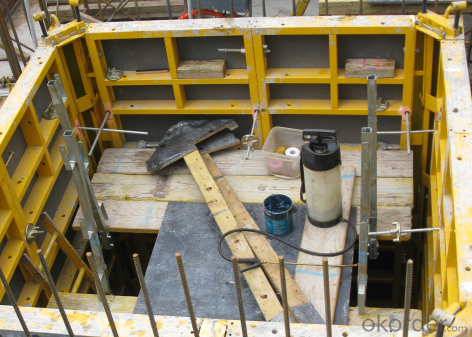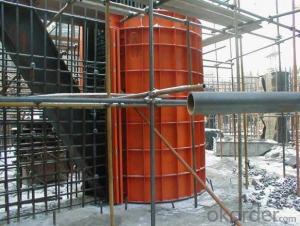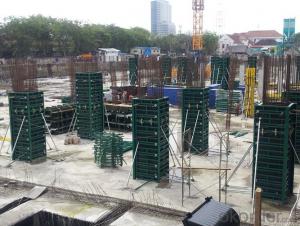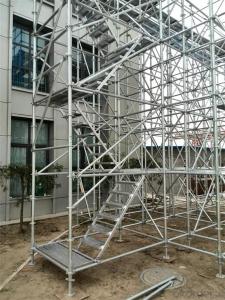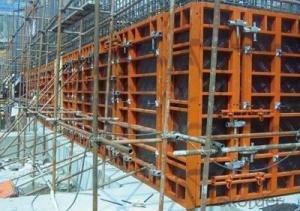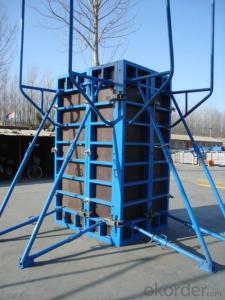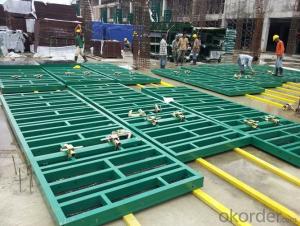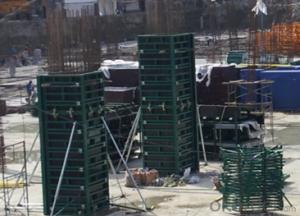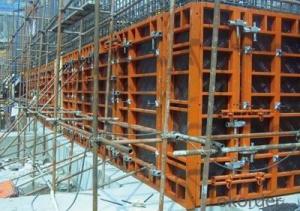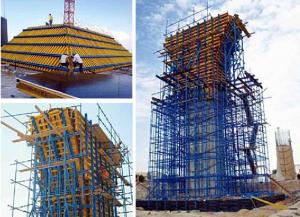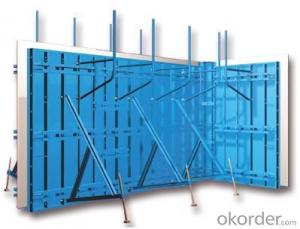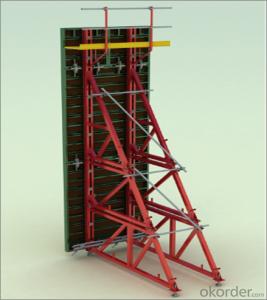COLUMN STEEL FRAMED FORMWORK FOR LIFT CONSTRUCTION
- Loading Port:
- Shanghai
- Payment Terms:
- TT OR LC
- Min Order Qty:
- 1000 m²
- Supply Capability:
- 100000 m²/month
OKorder Service Pledge
OKorder Financial Service
You Might Also Like
1. Structure of 120 Steel Framed Formwork Description
Single-side bracket is a kind of formwork for the concrete pouring of single-side wall. The construction is easy and fast. The components have good standard performance and versatility. The pouring height is adjustable, the maximum height of a single pouring is 8.9m.The formwork is always used in the concrete pouring of basement, subway, Sewage treatment factory and so on. The waterproof of the finished wall is excellent
2. Main Features of 120 Steel Framed Formwork
-easy to assemble
-simple structure.
-and convenient for transportation
-convenient for storage.
3. 120 Steel Framed Formwork Images
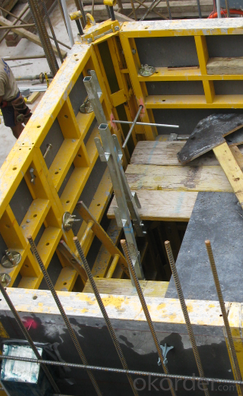
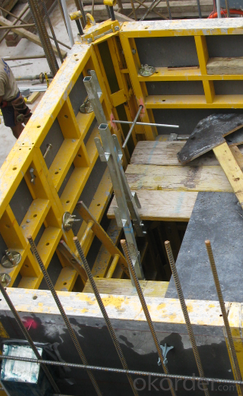
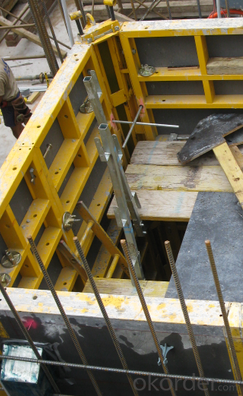
4. Single-side Steel Framed Formwork Specifications
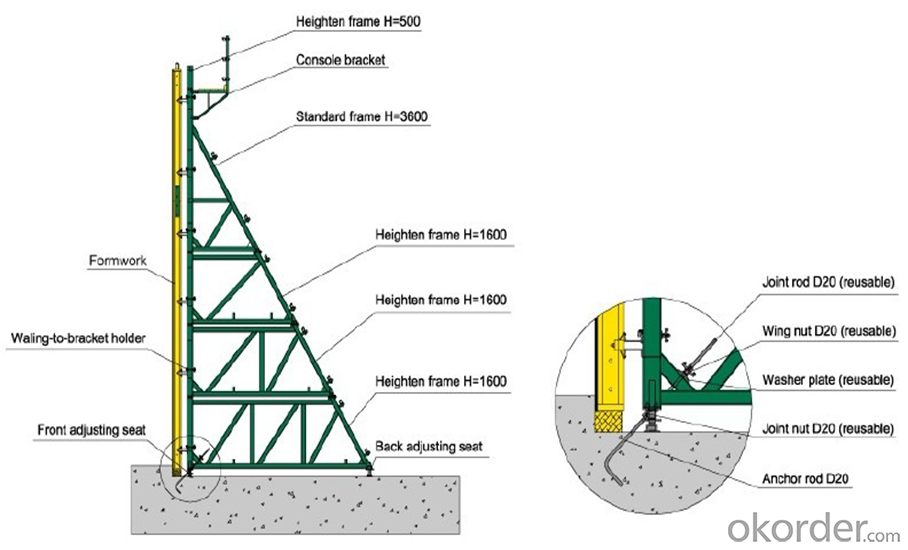
5.FAQ of 120 Steel Framed Formwork
1) What can we do for you?
.We can ensure the quality of the 120 steel framed formwork and avoid extra expenses for customers.
.We can provide you the professional technical team.
.We can provide professional building proposal for your project.
. Please feel free to customize.
2) What promises can be done by us?
. If interested in single side steel framed formwork, please feel free to write us for any QUOTE.
. If need any technical and building assistance, we could provide on-site professional staff for instruction.
. Please DO check goods when courier knocks your door and contact us asap if any issueS.
3) What about of our after-sale service?
. Response will be carried out in 24hours after receiving any complain or request.
. Single side steel framed formwork cost can be refund after order is confirmed.
. If the products are not based on the requirements, there will be the relevant compensations made for you.
4) What about the package and shipping time?
.Packing: wood package and
.Shipping: by sea
Shipping time: Normally small orders, it just1week business days to arrive your hand; When comes to the customs declaration, it may need 2 weeks.
- Q: What are the different types of form ties used in conjunction with steel frame formwork?
- There are several different types of form ties that are commonly used in conjunction with steel frame formwork. These form ties are essential for securing the formwork panels together and ensuring the stability and strength of the formwork system. 1. Loop Ties: Loop ties are one of the most commonly used types of form ties. They consist of a steel wire loop that is inserted through the formwork panels and then twisted or bent to secure the panels together. Loop ties are flexible and can accommodate different formwork configurations. 2. Flat Ties: Flat ties are another frequently used form tie. They are made of steel and have a flat shape, usually with holes or notches along the length. Flat ties are inserted through the formwork panels and secured using a wedge or a pin. They provide a strong connection between the panels and help maintain the formwork's structural integrity. 3. Snap Ties: Snap ties are a type of form tie that is designed for quick and easy installation. They consist of a metal rod with a button-like end that snaps into a plastic cone or washer. Snap ties are commonly used in applications where fast assembly and disassembly of the formwork is required. 4. Coil Ties: Coil ties are form ties made from coiled steel wire. They are typically used in situations where a high load capacity is required. Coil ties can be easily inserted through the formwork panels and secured using a coil nut or a coil rod. They provide a reliable and durable connection between the panels. 5. Cone Ties: Cone ties, also known as taper ties, are form ties that have a cone-shaped end. The cone end is inserted through the formwork panels and then secured using a wedge or a pin. Cone ties are commonly used in applications where a smooth and flush finish is desired, as the cone end can be easily removed after the concrete has cured. Overall, the choice of form tie depends on the specific requirements of the project, including factors such as load capacity, ease of installation, and desired finish. It is important to select the appropriate form tie to ensure the stability and strength of the steel frame formwork system.
- Q: Can steel frame formwork be integrated with other construction systems?
- Yes, steel frame formwork can be integrated with other construction systems. It is a versatile system that can be easily adapted and combined with various construction methods and materials, allowing for efficient and effective construction processes.
- Q: How is a steel frame formwork system assembled and disassembled?
- A steel frame formwork system is assembled by connecting prefabricated steel frames together in the desired configuration. The frames are then secured in place using clamps or pins. Once the concrete is poured and set, the system is disassembled by removing the clamps or pins and dismantling the steel frames, allowing for easy removal of the formwork.
- Q: Can steel frame formwork be used in areas with high noise levels?
- Yes, steel frame formwork can be used in areas with high noise levels. Steel is a durable and robust material that can withstand high levels of noise without being affected or compromised.
- Q: How does steel frame formwork contribute to better formwork stability in windy coastal areas?
- Formwork stability in windy coastal areas can be significantly improved with the use of steel frame formwork. This is due to the inherent strength and durability of steel, which allows it to withstand harsh coastal conditions and strong winds. As a result, steel frame formwork is an excellent choice for construction projects in these areas. The structural stability and resistance against strong winds provided by steel frame formwork are noteworthy. The rigid framework acts as a reliable support system for the formwork, ensuring that it remains in place even during gusty winds. This stability is crucial to maintain the integrity of the concrete structure being built, as it prevents any movement or displacement of the formwork. The stability of steel frame formwork is further enhanced by its heavy and sturdy design. The weight of the steel frame adds an extra layer of resistance against wind forces, making it less prone to being blown over or knocked down. This added weight helps to firmly anchor the formwork to the ground, preventing any potential damage or accidents caused by wind-related incidents. Furthermore, steel frame formwork can be customized to fit specific project requirements, making it highly adaptable. This flexibility allows for the design of formwork systems that can effectively withstand the unique challenges posed by windy coastal areas. By incorporating additional bracing or reinforcement, the formwork can be further strengthened to ensure maximum stability. In summary, steel frame formwork is a reliable and efficient solution for enhancing formwork stability in windy coastal areas. Its inherent strength, durability, and adaptability make it well-suited to withstand the challenges posed by high winds, providing a secure support system for concrete construction projects in these locations.
- Q: How does steel frame formwork handle architectural features such as openings and recesses?
- Steel frame formwork is highly versatile and can easily handle architectural features such as openings and recesses. It allows for customization and precision in design, enabling the creation of various shapes and sizes. The steel frames can be easily adjusted, modified, or removed to accommodate specific architectural features, ensuring a seamless integration of openings and recesses within the overall structure.
- Q: How does steel frame formwork contribute to better concrete curing in different weather conditions?
- Steel frame formwork contributes to better concrete curing in different weather conditions in several ways. Firstly, the steel frame provides stability and support to the formwork, ensuring that it remains intact and in place during adverse weather conditions such as heavy rain or strong winds. This prevents any potential damage or collapse of the formwork, ensuring the concrete is not exposed to the elements prematurely. Secondly, the steel frame formwork provides a barrier against moisture and temperature fluctuations, which are crucial factors in proper concrete curing. It helps to retain the moisture within the concrete, preventing excessive evaporation, especially in hot and dry weather conditions. This allows for a slower and more controlled curing process, reducing the risk of cracking or shrinkage. Additionally, the steel frame formwork allows for efficient insulation, which is beneficial in extreme weather conditions. It helps to maintain a stable temperature within the concrete, protecting it from freezing or overheating, which can adversely affect the curing process. Overall, the use of steel frame formwork provides a reliable and durable system that ensures proper concrete curing, regardless of the weather conditions. It helps to create a controlled environment for curing, resulting in stronger, more durable concrete structures.
- Q: How does steel frame formwork contribute to the overall construction process?
- The inclusion of steel frame formwork is essential in the construction process as it creates a strong and long-lasting framework for pouring concrete. This component offers various advantages that improve the efficiency and quality of construction projects. Firstly, steel frame formwork guarantees precise and accurate concrete pouring by providing a reliable support system. The robust and rigid structure of the steel frames allows for the creation of intricate shapes and structures, enabling architects and engineers to achieve their desired designs. This versatility in formwork design simplifies the construction of walls, columns, beams, and slabs. Furthermore, steel frame formwork is highly durable and capable of withstanding the immense pressure exerted by freshly poured concrete. This durability allows for repeated use, reducing the cost and waste associated with disposable formwork systems. The long-lasting nature of steel frame formwork also promotes sustainable construction practices by minimizing the need for frequent replacements. Moreover, the ease of assembly and disassembly of steel frame formwork contributes to increased construction speed. The standardized components and modular design of the system enable quick and efficient installation, saving valuable time on construction sites. This time-saving aspect is particularly advantageous in projects with strict deadlines or those requiring rapid construction. Additionally, steel frame formwork ensures excellent concrete finish and quality. The smooth surfaces produced by the steel frames reduce the need for additional surface treatments, saving both time and cost. The precision and accuracy of the formwork system also aid in achieving consistent results, ensuring uniformity and structural integrity in the final product. Lastly, steel frame formwork promotes a safer working environment. The sturdy and stable structure provides a secure platform for workers to carry out their tasks, minimizing the risk of accidents and injuries. Additionally, the use of steel frame formwork eliminates the need for traditional timber formwork, which can pose fire hazards on construction sites. In conclusion, steel frame formwork is a crucial element in the construction process as it provides a stable support system, enhances construction speed, ensures concrete quality, and promotes a safer working environment. Its durability, flexibility, and efficiency make it an indispensable component for modern construction projects.
- Q: How does steel frame formwork help in achieving accurate concrete leveling?
- Achieving precise concrete leveling is made possible with the use of steel frame formwork, as it offers a rigid and stable structure for pouring and shaping the concrete. Designed to be strong and durable, the steel frames maintain their shape and alignment throughout the entire pouring process. One major advantage of steel frame formwork is the ability to have precise control over the concrete placement and leveling. The frames can be easily adjusted and aligned to the desired height and slope, ensuring accurate pouring. This eliminates any inconsistencies or unevenness in the final concrete surface. Furthermore, steel frame formwork provides exceptional support and stability, preventing any deformation or movement during the pouring and curing of the concrete. This guarantees that the concrete maintains its intended shape and level, even under the pressure of the wet mix and its own weight. Additionally, the steel frames minimize the risk of concrete shrinkage and settlement, which can occur if the formwork is not adequately supported. By providing a strong and rigid structure, the frames distribute the weight of the concrete evenly, reducing the chances of sinking or settling after curing. Moreover, steel frame formwork is highly adaptable and can be easily customized to fit various shapes and sizes of concrete structures. This allows for accurate leveling, even in complex and irregular designs. In conclusion, steel frame formwork is essential in achieving accurate concrete leveling by offering a stable and adjustable structure for pouring and shaping. Its strength, stability, and versatility ensure that the concrete maintains its desired level and shape, resulting in a high-quality and level finished surface.
- Q: Can steel frame formwork be used in areas with high humidity levels?
- Yes, steel frame formwork can be used in areas with high humidity levels. Steel is a highly durable and corrosion-resistant material, making it ideal for use in humid environments. Additionally, steel formwork can be coated with protective coatings or rust inhibitors to further enhance its resistance to moisture. This makes it suitable for construction projects in coastal areas, tropical regions, or any other areas with high humidity levels. However, it is important to ensure proper maintenance and regular inspections to prevent any potential corrosion or damage to the steel frame formwork.
Send your message to us
COLUMN STEEL FRAMED FORMWORK FOR LIFT CONSTRUCTION
- Loading Port:
- Shanghai
- Payment Terms:
- TT OR LC
- Min Order Qty:
- 1000 m²
- Supply Capability:
- 100000 m²/month
OKorder Service Pledge
OKorder Financial Service
Similar products
Hot products
Hot Searches
Related keywords
